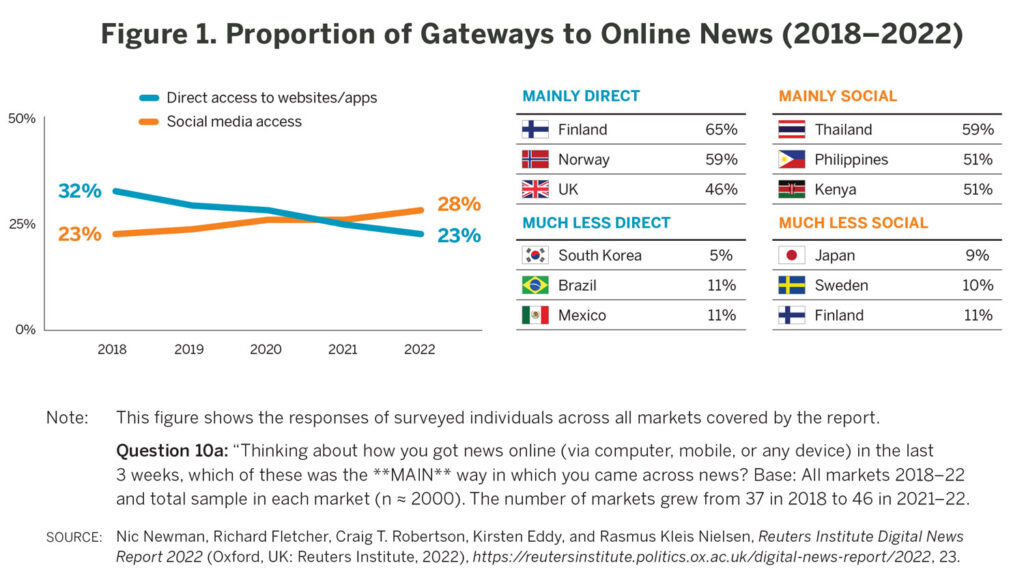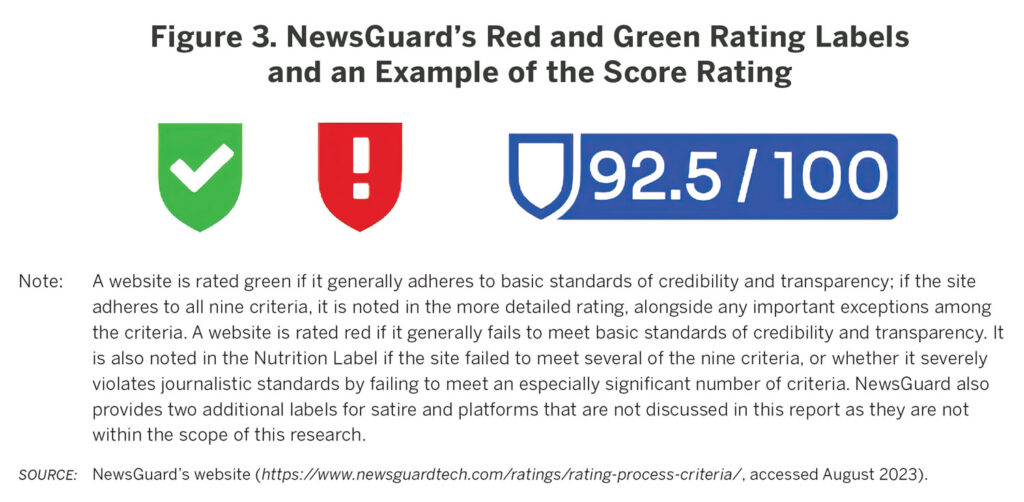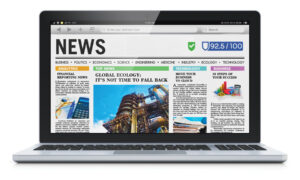Key Findings
In an online environment increasingly polluted with false information, trust in news has steadily eroded over the years. At the same time, high-quality news has been losing already scarce advertising revenue to clickbait and viral misinformation. Digital trust initiatives, which evaluate and label news outlets, aim to remedy these issues. While their definitions of what constitutes trustworthy news may vary, these initiatives share common goals: to help independent media outlets survive by making them stand out to audiences and advertisers.
– Trust labels aim to increase the visibility of high-quality journalism online, funnel more ad revenue to high-quality news outlets, and help audiences identify trustworthy content from false information.
– Evaluating journalistic processes and ethical standards, rather than individual pieces of news content, allows these initiatives to measure news outlets’ performance without impinging on editorial independence and free expression.
– These initiatives are still in their infancy. As a result, questions remain as to their impact on news sustainability and their potential for global scalability, particularly in developing countries and emerging democracies.
Introduction
In recent years, using online intermediaries such as social media, news aggregators, and search engines to access and read news online has become increasingly common, while direct access to news publishers has become less important.1 However, a global survey showed that 62 percent of online news consumers believe that they’ve seen misinformation online weekly.2 Indeed, social media platforms’ propensity to reward the sharing of engaging content without regard to whether or not it is factual has created a digital environment rife with misleading and false information.3 As users chase virality, misinformation gets amplified on these platforms and fact-checkers cannot keep up. By the time this content can be fact-checked, it will have already gotten its maximum engagement.4
What can be done to ensure that high-quality, independent journalism—instead of misinformation and clickbait—can still attract public attention when news dissemination is increasingly mediated by digital platforms? Several groups are now trying to solve this challenge by developing and promoting digital markers, akin to nutrition labels, that signify reliability and credibility of news online.
 The stakes are high. Online misinformation and disinformation are polluting public discourse in countries around the world and posing a fundamental challenge to democratic politics and social stability. But any effort to combat false information and propaganda must also strike a balance with the right to freedom of expression.5 This balancing act can be especially delicate in countries where governments use the threat of false information as a pretense to exercise greater control over the information space and attack independent, critical journalism.6
The stakes are high. Online misinformation and disinformation are polluting public discourse in countries around the world and posing a fundamental challenge to democratic politics and social stability. But any effort to combat false information and propaganda must also strike a balance with the right to freedom of expression.5 This balancing act can be especially delicate in countries where governments use the threat of false information as a pretense to exercise greater control over the information space and attack independent, critical journalism.6
Throughout history, journalism has set itself apart from other types of content by adhering to rigorous professional codes of ethics. Editor guilds, journalist associations, and media councils, among other self-regulatory bodies, have long emphasized this adherence, giving journalism a distinct identity. Such codes can be found published in various forms. They vary from country to country, but generally converge around commonly held journalistic norms such as transparency, accountability, quality, and editorial independence.
Such codes of ethics, however, have become increasingly irrelevant in a digitally mediated news environment. Social media algorithms remain almost entirely agnostic to content quality, partly because “engagement” translates into profitability and because platforms have eschewed editorial liability.7 While governments and regulators mull over how to work with social media and search engines to provide diverse, trustworthy news to the public, the media industry is attempting to address the problem8 from within through digital news trust initiatives—a digital solution to a digital problem.
These news trust initiatives refer to online tools that provide standards and indicators, developed for and by journalists and news organizations, that identify, categorize, and label news organizations based on those standards. “Trust” is the key word in these initiatives. Readers, platforms, advertisers, and news outlets must trust that these initiatives can fairly distinguish news from other content online. At the same time, trust is often vaguely defined and open to subjective interpretations, making it difficult to assess and benchmark. The task is fraught with challenges that news trust initiatives are aiming to solve. Many of these initiatives are relatively new, and largely untested in emerging democracies. But proponents of the approach claim that, if they get it right, they can simultaneously strengthen revenues for news outlets by drawing audiences to trustworthy journalism, and improve the health of digital news ecosystems by identifying false information online.
How Trust Was Lost Online
Online intermediaries have profoundly changed how news is produced and distributed and have established themselves as key gateways to journalism online. Historically, there was a “push” model, where news outlets were gatekeepers for what audiences could access. The digital sphere introduced a “pull” model, in which audiences were given greater ability to pick and choose the news content they consume.
The online news environment, however, is more push and less pull as users’ choices are guided by search engine and social media algorithms, which create carefully curated and personalized digital environments. Through these new forms of algorithmic gatekeeping, online platforms have intruded upon a process once dominated by journalists and editors.9 As the popularity of these services has grown, so has their importance within the news ecosystem. They now directly influence several key stages of the supply chain for news, ranging from production and curation of content to distribution, discovery, and monetization.10
People are increasingly bypassing direct access to news through news websites and apps in favor of curated news content on social media. In fact, this trend reached a tipping point in 2022, with social media access surging ahead of direct access to news via news apps and websites in many countries (see Figure 1).11 This has strengthened the gatekeeping power of social media and search engine companies, while weakening the control that news outlets have in terms of who consumes their content.
Although more and more users get their news online, trust in information from online sources is generally low.12 According to the Reuters Institute’s project “Trust in News,” there is a trust gap between “general news” and “news accessed online.” This phenomenon means that trustworthy news outlets risk undermining their brand “by association” as people come across their content on social media feeds that also offer a variety of other types of entertainment and information content, including sometimes mis- or disinformation.13
Online intermediaries have made the creation and dissemination of mis- and disinformation not only easy and cheap, but also increasingly viral.14 By rewarding engagement and sensationalism over quality and professionalism, they have exacerbated the rapid and rampant explosion of not only mis- and disinformation, but also politically polarizing news and propaganda.15 To address this, social media platforms and search companies have created trust and safety teams, partnered with fact-checking organizations, and taken other steps to snuff out the most harmful and egregious forms of disinformation. Nonetheless, the problem shows little sign of abating. Thus, in many countries, concerns about the quality of information and news online are at the forefront for news providers, researchers, policymakers, and civil society.16
The growing role of online intermediaries as gateways to news has also significantly impacted the business models of news organizations. On the one hand, social media, search engines, and news aggregators can help reach large audiences. On the other hand, they also “siphon off a substantial amount of advertising revenues in the process.”17 The demographic and behavioral targeting techniques that these intermediaries offer are irresistible for most online advertisers. However, despite the growth of the digital ad market,18 those revenues do not generally flow to publishers. On the contrary, social media platforms and search engines get the lion’s share of online advertising revenues. For example, Google and Meta capture more than half of digital advertising revenue.19
In 2022, 84 percent of digital advertising spending was placed using programmatic advertising, which uses data insights and algorithms to serve ads to specific kinds of audiences across websites.20 While programmatic advertising allows for advertising at scale targeted to specific demographics, it also means that brands have much less control over where their ads appear. This can expose brands to risk as their ads might be placed on sites that do not align with their values.
Programmatic advertising also drains money away from reputable news outlets. In 2021, $2.6 billion of the global programmatic advertising spend was directed to websites that repeatedly posted false and misleading content.21
Amid the often meager revenues that programmatic advertising provides for most news outlets, many publishers have increased their efforts to get audiences to pay for content online through subscriptions, memberships, or donations. This, however, has not made up for their advertising losses.22 In fact, the decline of advertising revenue and the dominance of a handful of digital platforms increasingly endangers the sustainability of most independent news organizations.23
It is clear that these are difficult times for news providers, and structural solutions are still lacking.
Several digital news trust initiatives have emerged in response to the decline in trust in news, the rise of mis- and disinformation online, the shift in gatekeeping power from editors to platforms, and the drop in advertising revenues for independent journalism. This report highlights three initiatives—The Trust Project, NewsGuard, and the Journalism Trust Initiative (JTI)—that aim to address these issues by establishing a global set of journalistic standards.
While these initiatives differ in important ways explored below, all aim to:
– Help users navigate the online news environment by evaluating and labeling news outlets that adhere to internationally accepted journalistic standards
– Potentialize the prioritization of trustworthy news outlets by generating machine-readable signals that online intermediary services can take into account for algorithmic content curation
– Improve revenue generation by promoting trustworthy news outlets to audiences and advertisers
One such initiative is24 The Trust Project, which started in 2014. This international consortium of news organizations developed a set of Trust Indicators® to encourage transparency about outlets’ processes and who owns them so users can make informed decisions about their news consumption.25 Another approach that utilizes a rating system is NewsGuard, a company founded in 2018 that assesses the trustworthiness of news sites through its “trust ratings.”26 NewsGuard seeks to provide users with the context they need to make their own judgments about the reliability of news sources. The Journalism Trust Initiative, which was launched in 2019, is another industry initiative that has developed a self-regulatory mechanism that enables news outlets to verify their compliance with journalistic best practices through an independent audit and earn a JTI certificate.
These three initiatives, if they were to be scaled up to the global level and used by key stakeholders, including platforms and advertisers, could make content produced by legitimate news outlets more visible, while diluting mis- and disinformation online. Theoretically, this would create a virtuous cycle in which the higher visibility of trustworthy news providers could also increase clicks and readership, and potentially lead to more advertising revenues. The ultimate goal of these digital news trust initiatives is to foster healthier and more sustainable news ecosystems online. This is easier said than done.
How do they distinguish “trustworthy” news from other kinds of content online? Are these initiatives capable of operating at a global scale, across vastly different country contexts, while safeguarding the trust and legitimacy of the process? Do these initiatives have the potential to truly deliver the impact they promise on news around the world? These questions are fundamental to understanding the broader value of these efforts and the ways they might help improve the conditions that affect the viability of news media globally.
How Trust Initiatives Seek to Shape Online News Systems
Digital news trust approaches aim to support independent, trustworthy media online by setting benchmarks that can differentiate them from the overabundance of untrustworthy information. However, each initiative differs in terms of the practical solutions designed to achieve this goal.
 The Trust Project combines the use of its Trust Indicators with a collaborative approach aimed at helping news providers achieve those benchmarks and earn a Trust Mark. NewsGuard focuses on digital media literacy for users by providing an external and independent assessment of news organizations and a labeling system that helps audiences make informed reading choices that contribute to a healthy news diet, akin to the nutrition labels used in the food industry. Finally, the Journalism Trust Initiative takes a more institutional route by setting industry-wide self-regulatory standards for news media, which are translated into machine-readable codes that, ideally, advertisers and platforms can use to inform their ad placement strategies and content curation and moderation practices.
The Trust Project combines the use of its Trust Indicators with a collaborative approach aimed at helping news providers achieve those benchmarks and earn a Trust Mark. NewsGuard focuses on digital media literacy for users by providing an external and independent assessment of news organizations and a labeling system that helps audiences make informed reading choices that contribute to a healthy news diet, akin to the nutrition labels used in the food industry. Finally, the Journalism Trust Initiative takes a more institutional route by setting industry-wide self-regulatory standards for news media, which are translated into machine-readable codes that, ideally, advertisers and platforms can use to inform their ad placement strategies and content curation and moderation practices.
Collaborative Approaches to Trust Indicators and Media Development
In 2014, The Trust Project was the first initiative to coin the notion of Trust Indicators based on professional journalistic norms and apply Trust Marks to news outlets that can help users easily recognize more trusted and high-quality news online.27
The Trust Project is a nonprofit, charitable organization based in Pacifica, California. The organization has been funded by Craig Newmark Philanthropies, Google, the Democracy Fund, the John S. and James L. Knight Foundation, Facebook, and the Markkula Foundation. The philanthropic support it receives means that it never charges news outlets to participate in the evaluation process or to display a Trust Project label.
According to The Trust Project’s philosophy, change cannot be achieved solely through a rating system, but requires a more collaborative and comprehensive approach.28 This is why the initiative’s main goal is to help each partner organization achieve high standards by offering dedicated trainings and expert support.29 Thus, it is not simply about assessment and compliance, but about the improvements that news organizations can make to be more transparent and accountable in their editorial, management, and financing processes.
The Trust Project operates as a consortium of news outlets that voluntarily sign up for an evaluation with the intent to improve their practices where needed and establish themselves as “trustworthy” journalism. Once a news outlet applies for the Trust Indicators, it undergoes an eligibility review. Once the outlet passes the review, it becomes part of a cohort that works with The Trust Project’s team to implement the indicators. The team provides the cohort training and guidance to achieve the expected accountability and quality.
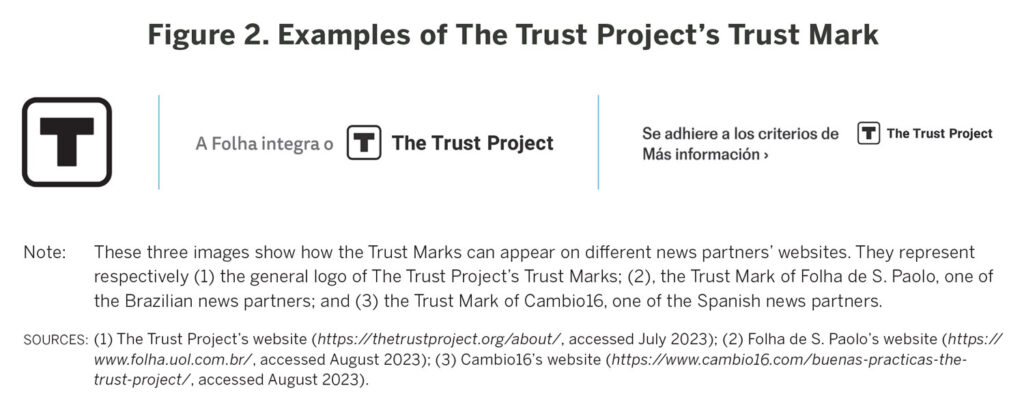 When a news outlet is able to respect all principles set out by The Trust Project, it officially becomes a participant in the consortium and is able to use the Trust Mark logo (Figure 2).30 The logo publicly showcases the organization’s commitment to transparency, accuracy, inclusion, and fairness, so that the public can ideally make more informed news choices. As of June 2023, The Trust Project has signed up more than 275 websites across 10 countries.31
When a news outlet is able to respect all principles set out by The Trust Project, it officially becomes a participant in the consortium and is able to use the Trust Mark logo (Figure 2).30 The logo publicly showcases the organization’s commitment to transparency, accuracy, inclusion, and fairness, so that the public can ideally make more informed news choices. As of June 2023, The Trust Project has signed up more than 275 websites across 10 countries.31
Throughout the years it has refined such training programs, developing a standard protocol and documentation package that is available only to news partners.32 In 2016, The Trust Project launched its Projeto Credibilidade chapter, which offers the same training packages and solutions in Portuguese to better serve the Brazilian news sector. While the general protocol and approach is the same, the type of assistance these initiatives provide to newsrooms can be adapted to the specific needs of each organization.33 In May 2021, the chapter merged into the parent organization, which is now operating directly in Brazil.
The Trust Project leverages a user-facing and machine-readable labeling system to incentivize transparency and accountability among news providers. While the Trust Indicators are publicly available, the evaluation process is not fully transparent to outsiders. Only the final evaluation of approved news providers is publicly accessible. However, even though the public does not see the scores, information on the methods news partners use to uphold the standards are publicly available.34 Furthermore, only successful partners are publicly announced. The project doesn’t single out untrustworthy news sources or disclose those that applied but did not manage to earn the Trust Mark.
External Labels of Trustworthiness and Media Literacy
Unlike The Trust Project, NewsGuard’s labeling systems are based on an independent evaluation of news outlets, providing a ranking system intended to signal both trustworthy and untrustworthy sources. The solution offered is centered on a combination of consumer-focused labeling and an evaluation method that is driven by expert assessment.
The NewsGuard browser extension was developed by NewsGuard Technologies, a for-profit corporation founded in 2018 and headquartered in New York. Initial investors included the Knight Foundation and the Publicis Groupe, a French multinational advertising and public relations company.35 NewsGuard does not charge the news outlets that it rates but generates revenue by charging social media platforms and search engines, among others, to license its ratings to include in their feeds and search results.36
The NewsGuard Nutrition Label was developed to increase users’ media literacy and enable them to make more informed choices while browsing online for news content. NewsGuard’s Nutrition Label (Figure. 3) assigns outlets a score of 0-100 points and provides an explanation of the review. It is designed to inform people about the quality of news they consume through online search engines or social media. This approach builds on the tendency of people to rely on mental shortcuts, providing behavioral nudges that can potentially impact their decisions.37 As of June 2023, NewsGuard has applied its ratings to 8,934 websites38 across nine countries.39
The intention is to help users distinguish reliable news sources from mis- and disinformation online and nudge them to access more trustworthy news sources. Theoretically, in the short-term, these rating systems could lower exposure to mis- and disinformation by reducing the likelihood that individuals click on misleading or unreliable sources of information. In the long-term, repeated exposure to indicators and ratings of trustworthiness could teach users to determine whether a news outlet is reliable and engender trust in news sources that adhere to high professional standards.
To achieve such behavioral changes, NewsGuard embeds its source-level indicators of news reliability into users’ search engine results pages, social feeds, and visited URLs.40 These indicators are used to assess selected news outlets and provide an overall rating of green (generally trustworthy) or red (generally untrustworthy). The traffic light system helps people instantly recognize whether a source is trustworthy. The Nutrition Label provides a longer review and includes additional information and context on the news source, such as who is behind the site, what kind of content it publishes, and why it received its rating.41
While the ultimate solution is a machine-readable code to be used in platforms’ automated processes, behind each label there is an independent assessment process carried out by NewsGuard’s editorial team. Broadly, this assessment process involves several stages of work. It starts with an in-depth analysis conducted by the NewsGuard analyst team, which assesses the website and its content (often this is done historically, and not just looking at the most recent content) against the nine criteria and informs the first draft of the Nutrition Label. This draft is then shared with the website’s proprietor to seek comments and feedback. The score and Nutrition Label are then reviewed and fact-checked by NewsGuard senior editors to complete the assessment before publishing the result. Finally, NewsGuard periodically reviews and updates its score and rating of each website where necessary.42
News organizations have the right to provide feedback on the proposed rating during the evaluation process. According to NewsGuard Co-CEO Gordon Crovitz, once the outlets have been rated, they are able to work with NewsGuard analysts to improve their journalistic practices based on the nine criteria and to improve their scores.43 NewsGuard claims that an unfavorable review can be an incentive for a news organization to improve its practices, but unsolicited ratings of this nature also run the risk of backlash from news outlets that score poorly.
Information labels come with limitations. Ultimately, they rely on users’ abilities and willingness to change their behaviors, and research suggests that audiences are not easily swayed by labels.44 Even though the NewsGuard label can provide cues, which have been shown to be associated with increased source credibility,45 in the current polarized and partisan online environment, “relatively subtle contextual information may not be a sufficiently powerful prod to shift perceptions of source credibility.”46
Furthermore, NewsGuard’s rating is visible only to users who download and subscribe to a paid monthly service to use its browser extension.47 As a result, it exacerbates existing digital inequalities by excluding those who are less tech savvy and those who are unable or unwilling to pay for a monthly membership.
Self-Regulatory Standards
Launched in 2019, JTI is a collaborative standard-setting process that established the first European technical standards for journalists and media outlets.48 The self-regulatory mechanism that JTI has helped create is designed to promote trustworthy journalism using clear and objective standards of transparency, accountability, and independence for news outlets. JTI combines the use of machine-readable benchmarks of quality, trustworthiness, and independence for media outlets with self-assessment and voluntary processes that invite interested organizations to comply with such standards and earn the JTI certificate.
JTI is operated by Reporters Without Borders (RSF), an international nonprofit based in Paris that promotes and defends the freedom, independence, and pluralism of journalism worldwide. JTI received funding from the European Commission, the Craig Newmark Philanthropies, the National Endowment for Democracy,49 and Agence Française de Développement (AFD). RSF has been, alongside AFD and the European Broadcasting Union, a convenor for the standardization workshop that led to the creation of JTI, but RSF has since taken charge of the implementation of such standards. The application and compliance of the certifiers with JTI’s standards is then surveyed by third-party auditors and recognized accreditors, such as Deloitte.50
The set of certifiable technical standards developed by JTI applies to media outlets themselves—defined by JTI as those entities that produce and disseminate journalistic content51—which self-assess their editorial processes and increase their transparency to gain the JTI certification mark (see Figure 4).52
While increasing users’ awareness of their news consumption is one of its objectives, the focus is on providing a standard-setting instrument that could be incorporated into social media platforms and search engines, and integrated with online advertising systems. To achieve systemic change, JTI openly calls on industry and policy actors, such as advertisers, platforms, and regulatory authorities, to support news organizations that comply with its standards.53
Advertisers could use JTI standards to responsibly allocate funds and financially support media that uphold norms of trustworthy journalism, which could limit the monetization of mis- and disinformation online.54 Social media platforms could integrate the JTI machine-readable indicators in their curation and prioritization processes to identify and surface more “authoritative sources of information online.”55 However, to date no such integration of JTI indicators into social media curation practices has occurred.
For even more structural change to take place, these standards could also be used to inform self-regulation or co-regulation to support trustworthy news.56 Self-regulatory bodies in the news industry could, for instance, prompt their members to comply with standards like JTI’s, or be assessed by companies like NewsGuard. An example of a co-regulatory approach in this area is the European Strengthened Code of Practice on Disinformation.57 The code encourages platforms and advertisers to use standards like JTI’s and other trustworthiness indicators to help users distinguish between reliable and unreliable news, as well as boost the exposure and monetization of reliable news while removing and demonetizing unreliable sources.58
 JTI is the result of a lengthy multistakeholder consultation process59 that discussed and agreed on a set of principles, which was finally approved through the official European Committee for Standardization (Comité Européen de Normalisation; CEN) protocol as a self-regulatory code for the news sector.60 Even though these are European criteria, news organizations outside of Europe can apply for certification. As a result, it is a system that is free from governmental oversight, but depends on self-evaluations and outside audits.
JTI is the result of a lengthy multistakeholder consultation process59 that discussed and agreed on a set of principles, which was finally approved through the official European Committee for Standardization (Comité Européen de Normalisation; CEN) protocol as a self-regulatory code for the news sector.60 Even though these are European criteria, news organizations outside of Europe can apply for certification. As a result, it is a system that is free from governmental oversight, but depends on self-evaluations and outside audits.
This more institutionalized approach to promoting reliable journalism has the potential to develop into a reward system that can encourage best practices among news organizations, boost the online visibility of reliable news, and generate more traffic, reach, and advertising revenue for them. Given the self-regulatory nature of this instrument, it is pivotal that the assessment and accreditation processes remain independent and auditable to guarantee that self-regulatory mechanisms are implemented through fair and accountable frameworks.61 To do so, news outlets that seek to be certified first have to conduct a self-evaluation based on JTI’s criteria and publish a transparency report with the results. Second, they must undergo an accreditation process conducted by a third-party surveyor, which controls the evidence and information provided by the organizations and ensures that they are complete, accurate, and aligned with the standards.62
Compared with those for NewsGuard and The Trust Project, the accreditation and certification through JTI and the third-party audits constitute a lengthier, more complex, and more costly process, but they are aimed at providing a transparent and accountable way of establishing and recognizing best practices in the sector. To support interested media outlets, JTI provides tools and support to enable them to voluntarily self-evaluate their editorial procedures, publish the findings, and undergo independent audits. As of May 2023, JTI has had more than 589 news outlets sign up to start the certification process, 64 transparency reports published, and 16 organizations complete the process.63
Although their methods differ, these initiatives share a long-term goal of building trust in the online news ecosystem by enhancing the reach and profitability of high-quality news outlets. In this sense, these solutions are not incompatible or unrelated. On the contrary, they represent a variety of potentially complementary solutions to the pressing challenges that independent news organizations face around the world.
The Challenge of Defining “Trustworthiness”
Beyond the differences among The Trust Project, NewsGuard, and JTI, the key conundrum that each digital news trust initiative strives to solve is a definitional one: how to define “trustworthy.” And once defined, how can it be operationalized into a set of objective and measurable criteria?
These three initiatives all began by adopting a principles-based approach to answering these questions, informed by existing professional journalism norms and relevant audience and academic research. However, JTI and The Trust Project applied a principles-based approach to defining their standards and indicators by applying them to organizational processes and journalistic practices rather than labeling or ranking individual articles. In other words, JTI and The Trust Project neither assess nor evaluate individual content, but they rely on the assumption that if news media have the appropriate and transparent principles guiding their systems and processes, they will tend to produce and distribute news content that is well-sourced, reliable, and respects high journalistic standards.
 On the other hand, NewsGuard presents a hybrid content- and principles-based approach. While the final score and Nutrition Label apply to the whole organization—so it is not a “quality label” that evaluates individual articles or journalists—some of NewsGuard’s criteria require an evaluation of individual pieces of content published by the assessed organizations. For instance, to assess whether a website “does not repeatedly publish false content” (criteria 1) or “avoids deceptive headlines” (criteria 5), the analyst and editorial team of NewsGuard have to review content and articles published by the organization. To do so, they conduct both an in-house investigation of sources, which combines the use of automated detection of content that was already flagged as containing false information by existing fact-checking networks and an internal analysis of such content. In this sense, it is a hybrid approach since the application of NewsGuard criteria involves an evaluation of content but the overall assessment and ranking applies to the organization as a whole and not individual journalists or articles.
On the other hand, NewsGuard presents a hybrid content- and principles-based approach. While the final score and Nutrition Label apply to the whole organization—so it is not a “quality label” that evaluates individual articles or journalists—some of NewsGuard’s criteria require an evaluation of individual pieces of content published by the assessed organizations. For instance, to assess whether a website “does not repeatedly publish false content” (criteria 1) or “avoids deceptive headlines” (criteria 5), the analyst and editorial team of NewsGuard have to review content and articles published by the organization. To do so, they conduct both an in-house investigation of sources, which combines the use of automated detection of content that was already flagged as containing false information by existing fact-checking networks and an internal analysis of such content. In this sense, it is a hybrid approach since the application of NewsGuard criteria involves an evaluation of content but the overall assessment and ranking applies to the organization as a whole and not individual journalists or articles.
Applying labels to news organizations, rather than on individual journalists or articles, could reduce the risk of interfering with internal content policies, which are under their editorial responsibility.64 It remains the responsibility of news outlets to categorize, curate, prioritize, and rank their own content as they see fit and not based on external indicators or standards. Applying “quality labels” to individual content or articles is perceived by these initiatives, as well as by institutions like the Council of Europe, as a potential threat to news outlets’ editorial freedom.65 Using criteria that assess the governance of news organizations, their transparency, and their independence could lead to more accountable practices that respect the editorial responsibility and freedom of these organizations, while prompting them to improve their professional norms and practices. Adding a fact-checking aspect to this, like NewsGuard does, can provide additional and more granular insights into the kinds of content published, but it is also costly and time consuming, and it partially overlaps with the work that existing fact-checking networks and communities are doing in this sphere.
Within this context, the question of how to define trustworthiness is answered in slightly different ways by each digital trust initiative, as evidenced by the sets of criteria they use to evaluate a news organization.
The Trust Project has eight indicators that news organizations must adhere to in order to gain a Trust Mark.66 The indicators cover a broad range of characteristics, from the ownership and funding structure of the organization to more specific information on their journalistic practices including data-gathering sources, fact-checking, impartiality, representation of diverse voices, and audience engagement. These criteria are meant to identify high-quality journalistic practices in the sector and reward them. Thus, the objective is to ensure that each news partner that earns a Trust Mark shows independence, accountability, and transparency in its journalistic practices, and this is done by evaluating the organization on the basis of eight criteria and related attributes.67 For instance, when it comes to the “best practices” criteria, The Trust Project assesses whether the news organization uses guidelines to protect “honest and independent reporting,” whether its mission and priorities are publicly available, and who funds and owns it. For the final evaluation, each criterion is equally weighed since news partners must comply with all Trust Indicators and their various attributes and requirements to gain the Trust Mark.
Broadly based on similar principles and informed by the Trust Indicators,68 NewsGuard developed nine indicators,69 and each criterion is broken down into more specific indicators that evaluate:
– How a site gathers and presents information
– Whether it regularly fact-checks its content or if it repeatedly reports or publishes content that has been found to be false
– The levels of transparency around ownership, funding, and types of content, differentiating between advertising, news, and opinion
– The accountability and accuracy of the sources and whether the site provides accurate and diverse viewpoints to its audiences.70
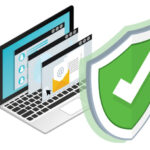 JTI has developed the most detailed and advanced set of indicators.71 The criteria are grouped under two sections, namely “identity and transparency” and “professionalism and accountability,” which are then divided into 17 subcategories that outline a more detailed code of conduct72 compared with NewsGuard’s and The Trust Project’s indicators. These 17 subcategories encompass a wide range of criteria intended to reflect what independent, transparent, and accountable news outlets should look like. The “identity and transparency” section includes, among other things, requirements around disclosure of ownership, management, and editorial teams, while the section on “professionalism and accountability” refers to criteria such as accuracy, fact-checking practices, diversity of sources, internal and external accountability mechanisms, and training in the newsroom.
JTI has developed the most detailed and advanced set of indicators.71 The criteria are grouped under two sections, namely “identity and transparency” and “professionalism and accountability,” which are then divided into 17 subcategories that outline a more detailed code of conduct72 compared with NewsGuard’s and The Trust Project’s indicators. These 17 subcategories encompass a wide range of criteria intended to reflect what independent, transparent, and accountable news outlets should look like. The “identity and transparency” section includes, among other things, requirements around disclosure of ownership, management, and editorial teams, while the section on “professionalism and accountability” refers to criteria such as accuracy, fact-checking practices, diversity of sources, internal and external accountability mechanisms, and training in the newsroom.
Each subcategory then presents a list of examples of how news outlets could fulfill such criteria. For instance, to fulfill the accuracy criteria, a news outlet should not simply provide information about its fact-checking practices, but also indicate how data are gathered and treated, where they are sourced, how editorial processes are reviewed, and what the roles of editorial and automated curation and dissemination processes are within the organization.73 Accountability is defined as both internal and external, referring to internal editorial processes and complaint-handling systems, as well as external oversight mechanisms such as an ombudsperson, press or media council, or statutory regulator.74
While transparency, accountability, and accuracy are criteria used by all three initiatives, standards related to independence and diversity, which are typically associated with public interest news by international institutions and policymakers, are explicitly included only in JTI and The Trust Project, where independence is a requirement to apply and be considered for the respective certification and Trust Mark.75 Furthermore, only JTI76 and The Trust Project77 explicitly mentions diversity as a core benchmarking criteria, which refers to the provision of content that reflects diverse sources, viewpoints, and perspectives. Independence from political, corporate, or other centers of power is another important aspect of trustworthy news media for JTI. Independent reporting is also a requirement for news outlets seeking to join The Trust Project. NewsGuard, however, does not include independence as one of its indicators.
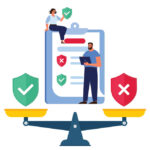 There is not yet a commonly agreed-upon set of criteria that can be used to define “trustworthy” or “public interest” news media. Even criteria that seem to be commonly shared can be defined, operationalized, and evaluated in different ways. For instance, NewsGuard is the only initiative that provides a hierarchy among these criteria through a weighted system.78 Based on this weighted system, the most important criterion is the lack of false content, followed by the presence of responsible and accurate reporting of information,79 while transparency of ownership, financing, and management structures are each individually valued less than accuracy and fact-checking.80
There is not yet a commonly agreed-upon set of criteria that can be used to define “trustworthy” or “public interest” news media. Even criteria that seem to be commonly shared can be defined, operationalized, and evaluated in different ways. For instance, NewsGuard is the only initiative that provides a hierarchy among these criteria through a weighted system.78 Based on this weighted system, the most important criterion is the lack of false content, followed by the presence of responsible and accurate reporting of information,79 while transparency of ownership, financing, and management structures are each individually valued less than accuracy and fact-checking.80
These differences raise questions as to the ability of these projects to resolve a definitional quandary that is normatively weighted and implies nebulous conceptions of trustworthiness. However, this is not a new challenge. The news industry has always struggled with such debates, which are simultaneously cultural, political, and social.81 Despite the fact that these digital news trust initiatives seek to provide innovative solutions for online news ecosystems, their core definitional challenges have long existed in news production.
The Challenge of Global Scale for Online Trust Indicators
Each of these initiatives claims to provide internationally applicable benchmarks and standards for trustworthy news, but none of them is truly global—not yet. Each of the three initiatives described in this report was developed mainly in Europe and the United States. They will face challenges in extending their influence, particularly in the diverse circumstances of emerging democracies and developing economies. Will local, national, and regional news providers seize on these initiatives to promote systemic change? And will key industry stakeholders such as advertisers and platforms respond favorably around the globe?
Uptake by News Outlets
Several obstacles are likely to emerge as the trust initiatives expand. First, the financial incentives for news publishers are not clear since the link between increased website traffic and increased revenue is uncertain.82 Second, some aspects of their standards may be ill-suited for news outlets operating in authoritarian regimes with repressive media systems, and questions remain on whether the standards will be viewed as universally legitimate. Finally, news outlets in emerging democracies and developing economies are frequently operating with limited resources. Ensuring that trust certificates, such as the ones bestowed by The Trust Project and JTI, remain inclusive of small, independent outlets will likely have resource implications.
 Representatives from The Trust Project, NewsGuard, and JTI argue that, based on their experiences, their criteria can be universal, and that demand for this approach exists around the world. Since its inception, The Trust Project has worked collaboratively with local and national media organizations across 13 countries: Canada, the United States, Panama, Brazil, Peru, Argentina, Belgium, the United Kingdom, Germany, Greece, Italy, Spain, and Hong Kong.83 Building on this experience, they launched the Projeto Credibilidade chapter, the Brazilian version of The Trust Project, which was created in response to the positive feedback and requests received from news outlets in Brazil. While the trainings need to be adapted to the national context and specific needs of each organization, the indicators and protocols appear to be applicable in a variety of countries.84
Representatives from The Trust Project, NewsGuard, and JTI argue that, based on their experiences, their criteria can be universal, and that demand for this approach exists around the world. Since its inception, The Trust Project has worked collaboratively with local and national media organizations across 13 countries: Canada, the United States, Panama, Brazil, Peru, Argentina, Belgium, the United Kingdom, Germany, Greece, Italy, Spain, and Hong Kong.83 Building on this experience, they launched the Projeto Credibilidade chapter, the Brazilian version of The Trust Project, which was created in response to the positive feedback and requests received from news outlets in Brazil. While the trainings need to be adapted to the national context and specific needs of each organization, the indicators and protocols appear to be applicable in a variety of countries.84
Similarly, NewsGuard has applied their nine criteria in Ukraine and Venezuela, which shows promise in terms of the ability to scale up and extend this initiative beyond the United States and Europe.85 JTI is using different engagement and reach strategies by establishing collaborations with auditing bodies in different countries, like the Alliance for Audited Media in the United States, and allowing nongovernmental organizations to become auditors.86 There has also been significant support in Europe. In October 2022, the foreign ministers of Andorra, Bulgaria, Czechia, Estonia, France, Greece, Iceland, Lithuania, Luxembourg, Slovakia, and Slovenia signed a declaration that included language supporting JTI and encouraging other countries to do the same.87 To further expand the pool of certifiable organizations, RSF and JTI will make more grants available to news outlets around the world to support them and partially cover the costs of the external audit process.
The efforts made so far by these trust initiatives point to important investments in training and partnerships that can help adapt their methodologies to contexts around the world. The success of those partnerships will depend on their ability to foster local ownership and legitimacy in these initiatives.
Trust Indicators in Content Moderation and Prioritization Practices
The level of engagement between these initiatives and online platforms has varied significantly. In their content policies and guidelines, social media platforms and search engines have developed definitions of concepts like “quality,” “trustworthiness,” “public interest,” and “authoritativeness.”88 In these processes, some of them have consulted and engaged with The Trust Project, NewsGuard, and JTI. One of the objectives of providing machine-readable solutions—like the two rating systems and the standards certifications of these three initiatives—is to ensure that their solutions can be applied on every platform that functions as a gateway to news online. This goal has not yet been fully realized, and strategies vary depending on the initiative and social media company.
 The Trust Project, for instance, was able to informally engage with Alphabet, Meta, and Microsoft, which now appear to be relying on the Trust Indicators for their own ranking systems and content curation and moderation practices. Google News uses the Trust Indicators in its systems in various ways, while Facebook uses the Trust Indicators in its process to index news pages, which could qualify indexed pages for policies and programs that benefit news publishers. In 2017, Facebook also tested a feature allowing publishers to display Trust Indicators through an icon that would appear in posts linking to news articles, which users can tap to see more information on the publisher.89 Similarly, Bing uses the Trust Indicator labels to display whether an article is news, opinion, or analysis, providing information that people need to understand an article’s context.90 While these are steps in the right direction, the approach is still fragmented and lacks transparency.
The Trust Project, for instance, was able to informally engage with Alphabet, Meta, and Microsoft, which now appear to be relying on the Trust Indicators for their own ranking systems and content curation and moderation practices. Google News uses the Trust Indicators in its systems in various ways, while Facebook uses the Trust Indicators in its process to index news pages, which could qualify indexed pages for policies and programs that benefit news publishers. In 2017, Facebook also tested a feature allowing publishers to display Trust Indicators through an icon that would appear in posts linking to news articles, which users can tap to see more information on the publisher.89 Similarly, Bing uses the Trust Indicator labels to display whether an article is news, opinion, or analysis, providing information that people need to understand an article’s context.90 While these are steps in the right direction, the approach is still fragmented and lacks transparency.
NewsGuard has maintained a more commercially oriented approach in establishing strategic relations with tech companies. For instance, it has successfully established a partnership with Microsoft, which has now integrated the NewsGuard browser extension into Microsoft Edge, offering its users this service at no extra cost.91 However, others, particularly social media platforms, have been reluctant to pursue this route.92
Finally, JTI has also engaged with key stakeholders at a more institutional and regulatory level. Since its launch, JTI has called for more structural interventions to support trustworthy news organizations and curb the gatekeeping power of tech companies and their intermediary services. In addition to news consumers and producers, its standards are aimed toward social media and search platforms that can use the JTI data to index and promote trusted news sources. The core problem JTI is trying to address is that online platforms tend to amplify the extremes—sensationalism, rumors, hate, and falsehoods. In this environment, public interest journalism can be unfairly disadvantaged, losing reputation, reach, and revenue—“that logic needs to be reversed.”93
In JTI’s view, indicators and standards alone cannot reverse the logic if they are not adopted by those that control distribution, curation, and discovery of content online.94 This was highlighted in the 2022 European Strengthened Code of Practice on Disinformation, which encourages platforms to combine content removal or de-prioritization alongside increasing the visibility of news sources that uphold high professional norms and conform with existing international standards, like those of the JTI.95
However, in moving from self-regulatory standards to co-regulatory frameworks, which combine media self-regulation with state regulation, it is important to consider the potential unwanted consequences of these interventions. Singling out specific organizations without having the right transparency, accountability, and external auditing mechanisms could create distortions in media markets. Likewise, government or political interference could weaponize labeling systems, negatively impacting media pluralism, media freedom, and freedom of expression online.96
Potential Changes in the Distribution of Advertising Revenues
Although advertising remains a fundamental yet declining source of revenue for news providers, these digital news trust initiatives have had limited success to date with advertisers, despite efforts to engage with this stakeholder group.
JTI has called for advertisers to use its standards to financially support more trusted sources. The initiative recommends that advertisers strengthen their brand safety by reducing the risk of being associated with mis- or disinformation and by aligning their spending and investments with JTI-conforming news sources.97
NewsGuard has applied a more business-oriented approach by offering another product called BrandGuard, which uses the Nutrition Label and a rating system to help advertisers, agencies, and ad-tech companies make decisions adhering to its standards for advertising on credible news sites and avoid misinformation sources.98 This product was particularly successful during the COVID-19 pandemic thanks to strategic partnerships with advertising agencies like Publicis Groupe99 and IPG Mediabrands.100 On top of this, it also launched Responsible Advertising for News Segments in 2022 to further help agencies and brands advertise on high-quality news sources and to increase the uptake among advertisers.101
Another promising approach to getting brands on board with channeling advertising to trustworthy media outlets is Ads for News. However, unlike The Trust Project, NewsGuard, and JTI, Ads for News does not include a public-facing label or generate a machine-readable code that could be used for algorithmic boosting by online platforms.
Public information on whether advertisers are using JTI standards or Trust Marks to make their investment decisions is still limited, as are the revenue impacts for news outlets. However, the use of NewsGuard’s products—especially BrandGuard and Misinformation Fingerprints, an initiative using artificial intelligence to recognize false narratives online and block ads from appearing on misinformation sites—have had a higher take-up among advertisers that work to reduce programmatic advertising spent on mis- and disinformation.102 For instance, in 2020, NewsGuard worked with one of its large advertising clients to identify 1,259 trustworthy news and information sites to advertise on, and helped a major advertiser avoid seven million impressions on mis- and disinformation sites.103
Furthermore, in its efforts to support the brand safety of agencies and advertisers, NewsGuard has also announced the expansion of its rating and Nutrition Label to TV news104 and news podcasts.105 While this has the potential to guide advertisers’ spending toward more trustworthy and reliable content, it also means that NewsGuard is moving even more into content quality labels, rather than principles-based approaches that assess organizational systems and processes.
Though these efforts can reduce the monetization of dis- and misinformation, while financially rewarding trustworthy news outlets, additional assessments are still needed to quantify their impacts and better understand whether they positively impact media sustainability in the digital sphere in the long-term. Ultimately, these initiatives are still in their infancy, and it might be too early to see whether they can have a positive economic impact for news providers at national, local, and international levels.
Conclusions
Digital trust initiatives strive to address complex problems and have multiple goals: from empowering users, to improving journalistic practices, to driving audiences and revenues to trusted news sources—and they cannot achieve such goals alone. Bolstering trustworthy news outlets and the content they produce in the digital information ecosystem is no easy undertaking. It entails interfacing with a diverse set of stakeholders—readers, journalists, news organizations, platforms, and advertisers—all of whom have distinct behaviors, goals, and incentives. Yet, the potential payback is immense if all the parts in this complex system can be aligned toward a similar objective.
 Cooperation among these initiatives as well as with other key industry actors in this sector will be key. There are signs that such collaboration is underway. The JTI emergency protocol powered by NewsGuard aims to support news outlets at risk and will be tested for the first time in Ukraine later this year.106 It is a potentially promising example of how these initiatives can work together to help newsrooms around the world establish their credibility and transparency in times of crisis.
Cooperation among these initiatives as well as with other key industry actors in this sector will be key. There are signs that such collaboration is underway. The JTI emergency protocol powered by NewsGuard aims to support news outlets at risk and will be tested for the first time in Ukraine later this year.106 It is a potentially promising example of how these initiatives can work together to help newsrooms around the world establish their credibility and transparency in times of crisis.
There are also indications of increased cooperation between these initiatives and tech companies. A recently launched project shows the potential for collaboration among multiple digital news trust initiatives and online platforms: the Microsoft Journalism Hub,107 a resource center built to connect the journalism community with tools, technology, services, and partner programs. Among its features, it includes NewsGuard’s indicator tools and offers support for JTI’s certification program.108
Digital trust initiatives have set ambitious goals, but their ambitions for change at a global scale remain largely unproven as these efforts are still quite young. Additionally, the opacity of platforms’ content curation and moderation processes, and the lack of data on advertisers’ investment decisions, contributes to a dearth of concrete evidence on how these actors are actually using these indicators and standards—if they are using them at all. The extent to which these initiatives will gain broader traction is yet to be seen.
As these digital news trust initiatives expand globally—including in emerging democracies and developing economies—it is important to consider the local and national circumstances, which might not always be compatible with the solutions proposed by these projects or with the mechanisms they’re employing. While the ultimate goal is to draw more readership and potentially more revenue to trusted, high-quality news sources, it is still unclear the extent to which this will play out in a meaningful way in different news markets.
Footnotes
- Based on the Digital News Report 2023, at an aggregate level, we reached a tipping point in the last few years, with social media preference (30 percent) now stretching its lead over direct access (22 percent). Behind these averages though, there remain substantial differences across the countries surveyed by the Reuters Institute. For instance, news brands in some northern European markets still have strong direct connections with consumers when it comes to online news, even though platforms are still almost universally used in these markets for a range of other purposes. By contrast, in parts of Asia, Latin America, and Africa, social media is by far the most important gateway, leaving news brands much more dependent on third-party traffic. In other Asia-Pacific markets—such as Japan and South Korea—homegrown portals such as Naver and Yahoo! are the primary access points to content, while in India and Indonesia, mobile news aggregators play an important gateway role. See Nic Newman, Richard Fletcher, Kirsten Eddy, Craig T. Robertson, and Rasmus Kleis Nielsen, Reuters Institute Digital News Report 2023 (Oxford, UK: Reuters Institute, 2023), https://reutersinstitute.politics.ox.ac.uk/sites/default/files/2023-06/Digital_News_Report_2023.pdf.
- A Global Study on Information Literacy: Understanding Generational Behaviors and Concerns around False and Misleading Information Online (St. Petersburg, Florida: Poynter Institute for Media Studies, August 2022), https://www.poynter.org/wp-content/uploads/2022/08/A-Global-Study-on-Information-Literacy-1.pdf.
- Gizem Ceylan, Ian A. Anderson, and Wendy Wood, “Sharing of Misinformation Is Habitual, Not Just Lazy or Biased,” PNAS 120, no. 4 (January 17, 2023): e2216614120, https://www.pnas.org/doi/10.1073/pnas.2216614120.
- Jeff Allen, “Misinformation Amplification Analysis and Tracking Dashboard,” Integrity Institute, October 13, 2022, https://integrityinstitute.org/blog/misinformation-amplification-tracking-dashboard.
- Kalina Bontcheva and Julie Posetti, eds., Balancing Act: Countering Digital Disinformation while Respecting Freedom of Expression (Geneva: International Telecommunication Union; Paris: UNESCO, September 2020), https://en.unesco.org/publications/balanceact.
- Gabrielle Lim and Samantha Bradshaw, Chilling Legislation: Tracking the Impact of “Fake News” Laws on Press Freedom Internationally (Washington, DC: Center for International Media Assistance, July 2023).
- Social media companies are incentivized to keep expanding their user bases to entice more advertisers to their platforms. Since misinformation tends to draw more user engagement, social media algorithms tend to prioritize such content. Because social media platforms are not legally liable for the content on their platforms, they have few incentives to change these systems. See Greg McFarlane, “How Facebook (Meta), Twitter, Social Media Make Money from You,” Investopedia, December 2, 2022, https://www.investopedia.com/stock-analysis/032114/how-facebook-twitter-social-media-make-money-you-twtr-lnkd-fb-goog.aspx#toc-social-medias-real-purpose; Katie Langin, “Fake News Spreads Faster than True News on Twitter—Thanks to People, Not Bots,” Science, March 8, 2018, https://www.science.org/content/article/fake-news-spreads-faster-true-news-twitter-thanks-people-not-bots; Barbara Ortutay, “What You Should Know about Section 230, the Rule that Shaped Today’s Internet,” PBS, February 21, 2023, https://www.pbs.org/newshour/politics/what-you-should-know-about-section-230-the-rule-that-shaped-todays-internet.
- Eleanora Mazzoli, “Journalists Step In Where Platforms Nave No Answers,” edited by Reece Hooker, Sara Phillips, and Andrew Jaspan, 360info, February 14, 2022, https://360info.org/?doi=10.54377/9583-ab37.
- See, for example, J. Wallace, “Modeling Contemporary Gatekeeping: The Rise of Individuals, Algorithms and Platforms in Digital News Dissemination,” Digital Journalism 6, no. 3 (2018): 274-293.
- Conrad Roeber, “Ofcom Media Plurality: News Ecosystem Dependencies Mapping,” Ofcom, August 9, 2022, https://www.ofcom.org.uk/__data/assets/pdf_file/0023/247550/annex-8-conrad-report.pdf.
- Nic Newman, Richard Fletcher, Craig T. Robertson, Kirsten Eddy, and Rasmus Kleis Nielsen, Reuters Institute Digital News Report 2022 (Oxford, UK: Reuters Institute, 2022), https://reutersinstitute.politics.ox.ac.uk/digital-news-report/2022, 23-24. While the graph reports cross-market averages, it should be noted that there are major differences among markets. For instance, audiences in Nordic European countries and the United Kingdom still have strong connections with news brands and their apps/websites, while people in Japan and South Korea tend to access news via aggregators and search engines, relying less and less on direct sources. These differences can be related to a number of factors, from the strength of news brands in a digital work to various levels of audience trust to the societal, political, and economic context of each country.
- See, for example, N. Newman, R. Fletcher, A. Schulz, et al., Reuters Institute Digital News Report 2021 (Oxford, UK: Reuters Institute, 2021), https://reutersinstitute.politics.ox.ac.uk/sites/default/files/2021-06/Digital_News_Report_2021_FINAL.pdf; and Newman et al., Reuters Institute Digital News Report 2022.
- Benjamin Toff, Sumitra Badrinathan, Camila Mont’Alverne, et al., “Overcoming Indifference: What Attitudes towards News Tell Us about Building Trust,” Reuters Institute, September 9, 2021, https://reutersinstitute.politics.ox.ac.uk/overcoming-indifference-what-attitudes-towards-news-tell-us-about-building-trust#header–2.
- See, for example, Sophie Lechler and Jana L. Egelhofer, “Disinformation, Misinformation, and Fake News, Understanding the Supply Side,” in Knowledge Resistance in High-Choice Information Environments (1st ed.), edited by J. Strömbäck, Å. Wikforss, K, Glüer, T. Lindholm, and H. Oscarsson (Oxfordshire, UK: Routledge, 2022), https://doi.org/10.4324/9781003111474.
- Andrew M. Guess and Benjamin A. Lyons, “Misinformation, Disinformation, and Online Propaganda,” in Social Media and Democracy: The State of the Field, Prospects for Reform, edited by Nathaniel Persily and Joshua A. Tucker (Cambridge: Cambridge University Press, 2020), 10–33; Barberá Pablo, “Social Media, Echo Chambers, and Political Polarization,” in Social Media and Democracy: The State of the Field, Prospects for Reform, edited by Nathaniel Persily and Joshua A. Tucker (Cambridge: Cambridge University Press, 2020), 34–55.
- Newman et al., Reuters Institute Digital News Report 2022.
- Philip M. Napoli, Social Media and the Public Interest: Media Regulation in the Disinformation Age (1st ed.) (New York: Columbia University Press, 2019), https://doi.org/https://doi.org/10.7312/napo18454, 40.
- “Insider Intelligence Slashes Global 2022 Ad Spend Forecast by Nearly 6%,” Insider Intelligence, November 9, 2022, https://www.insiderintelligence.com/newsroom/index.php/insider-intelligence-slashes-global-2022-ad-spend-forecast-by-nearly-6/#:~:text=TOTAL%20DIGITAL&text=We%20now%20project%202022%20digital,15.6%25%20growth%20to%20%24602.25%20billion.
- See, for example, Ethan Cramer-Flood, “Duopoly Still Rules the Global Digital Ad Market, but Alibaba and Amazon Are on the Prowl,” eMarketer, Insider Intelligence, May 10, 2021, https://www.emarketer.com/content/duopoly-still-rules-global-digital-ad-market-alibaba-amazon-on-prowl.
- See Statista Research Department, “Digital Ad Spend Worldwide 2017-2026, by Purchase Method,” Statista, January 6, 2023, https://www.statista.com/forecasts/1316147/programmatic-share-digital-ad-spend-worldwide#:~:text=In%202022%2C%20ads%20bought%20programmatically,to%2087%20percent%20by%202026.
- See “Programmatic Advertising Revenue of Misinformation Publishing Sites in the United States and Worldwide in 2021,” Statista Research Department, 2023, https://www.statista.com/statistics/1253292/misinformation-publishers-advertising-revenue/, accessed July 2023.
- See, for example, Newman et al., Reuters Institute Digital News Report 2022, 18-19.
- Courtney Radsch, Making Big Tech Pay for the News They Use (Washington, DC: Center for International Media Assistance, 2022), https://doi.org/10.2139/ssrn.4192026.
- The initiatives were selected based on a systematic literature review of relevant academic and gray literature, interviews with experts in the field, and an in-depth review of the Credibility Coalition database. The Credibility Coalition is a research community of journalists, researchers, academics, students, policymakers, technologists, and engaged non-specialists that has created a catalogue of local, national, and international initiatives and projects aimed at addressing issues of dis- and misinformation in today’s news and information systems. The digital news trust initiatives discussed in this report were therefore identified and selected by combining the insights gathered from these three data sources.
- The Trust Project is an international consortium of news organizations promoting standards of transparency and working with technology platforms to affirm and amplify journalism’s commitment to transparency, accuracy, inclusion, and fairness so that the public can make informed news choices. It is based on a user-centered design process that relies on Trust Indicators and a collaborative evaluation process of its news media partners. See “Frequently Asked Questions,” The Trust Project, n.d., https://thetrustproject.org/faq/, accessed July 2023.
- NewsGuard is a US-based organization founded in 2018 by former journalists Steven Brill and L. Gordon Crovitz that provides a program (and a related internet browser extension) to assess, rate, and mark news outlets with the intended goal of helping users identify trustworthy and quality journalism while reducing their consumption of misinformation online. In addition to the NewsGuard rating system, the organization also offers several solutions for industry actors, such as platform organizations and advertisers, to address the broader and more structural issues around misinformation online. For more, see NewsGuard’s website: https://www.newsguardtech.com/.
- Personal communication with Sally Lehrman, the Trust Project’s founder and CEO, October 2022.
- Ibid.
- Ibid.
- At the time of writing, there were at least 120 news organizations including, for instance, CBC News, The Economist, Folha de S. Paulo, La Información, El País, Il Sole 24 Ore, and the Washington Post. See the current list on The Trust Project’s website: https://network.thetrustproject.org/brands.
- Personal communication with Sally Lehrman, June 2023. This data was accurate as of June 2023.
- The resources that the Trust Project offers are available only for news partners and not the public. For more about The Trust Project’s resources, visit “The Trust Project Resources” web page: https://thetrustproject.org/resources/.
- Personal communication with Sally Lehrman, October 2022.
- To access the evaluation form of all news partners, see the dedicated page on the Trust Project’s website: https://network.thetrustproject.org/, accessed August 2023. Each news partner can then showcase the Trust Mark and a link to the evaluation form on their own website.
- Edmund Lee, “Veterans of the News Business Are Now Fighting Fakes,” New York Times, January 16, 2019, https://www.nytimes.com/2019/01/16/business/media/media-steve-brill-fake-news.html.
- See “Why Should You Trust Us?” NewsGuard, n.d., https://www.newsguardtech.com/about/why-should-you-trust-us/, accessed July 2023.
- See, for instance, Richard Thaler, Cass R. Sunstein, and John P. Baltz, “Choice Architecture,” In The Behavioral Foundations of Public Policy, edited by Elda Shafir (Princeton, NJ: Princeton University Press, 2013); Cass R. Sunstein, Why Nudges? The Politics of Libertarian Paternalism (New Haven: Yale University Press, 2015); and Karen Yeung, “‘Hypernudge’: Big Data as a Mode of Regulation by Design,” Information Communication and Society 20, no. 1 (2016): 118–36, https://doi.org/10.1080/1369118X.2016.1186713.
- Personal communication with Gordon Crovitz, NewsGuard’s co-CEO, June 2023. This data was accurate as of June 2023.
- NewsGuard reviews only websites that are parent domains, not subdomains. The nine countries covered include the United States, Canada, the United Kingdom, Germany, France, Italy, Austria, Australia, and New Zealand.
- Personal communication with Gordon Crovitz, September 2022.
- Ibid.
- Ibid.
- Ibid.
- See, for instance, Kevin Aslett, Andrew M. Guess, Richard Bonneau, Jonathan Nagler, and Joshua A. Tucker, “News Credibility Labels Have Limited Average Effects on News Diet Quality and Fail to Reduce Misperceptions,” Science Advances 8, no. 18 (2022), https://doi.org/10.1126/SCIADV.ABL3844; James Devitt, “Does Presenting Credibility Labels of Journalistic Sources Affect News Consumption? New Study Finds Limited Effects,” New York University, May 6, 2022, https://www.nyu.edu/about/news-publications/news/2022/may/does-presenting-credibility-labels-of-journalistic-sources-affec.html; and Knight Foundation, Assessing the Effect of News Source Ratings on News Content (Washington, DC: Gallup; Miami, FL: Knight Foundation, 2018), https://knightfoundation.org/reports/assessing-the-effect-of-news-source-ratings-on-news-content/.
- C.I. Hovland, I.L. Janis, and H.H. Kelley, Communication and Persuasion, APA PsycNet (New Haven: Yale University Press, 1953), https://psycnet.apa.org/record/1953-15071-000.
- See Aslett et al., “News Credibility Labels,” 7.
- NewsGuard offers only a two-week free trial of its browser extension. After that, membership costs $4.95 per month in the United States, £4.95 in the United Kingdom, and €4.95 in the European Union. Institutions like universities, schools, and private companies can also purchase institutional memberships available for all their employees. For more information, see the NewGuard website: https://www.newsguardtech.com/how-it-works/.
- As part of its first phase, JTI has developed a standardization instrument, in line with International Organization for Standardization protocols and published by the European Committee for Standardization, CEN in line with EU Regulation (EC) No 765/2008. From 2021 onwards, as part of its implementation phase, JTI offers online tools and additional support for media outlets to voluntarily self-assess their editorial processes, to publish the results and to get independently audited. The pilot project of this implementation phase, “Fostering qualitative media by rewarding reliable sources – Journalism Trust initiative” is co-funded by the European Commission, DG Connect. See JTI’s website for more information: https://www.journalismtrustinitiative.org/.
- The Center for International Media Assistance (CIMA) is housed within the National Endowment for Democracy. However, CIMA is not involved with the endowment’s grantmaking activities.
- Personal communication with Thibaut Bruttin, assistant director general at Reporters Without Borders (RSF), and Chloé Fiodiere, global manager of the JTI, May 2023.
- Under the CEN Workshop Agreement: Journalism Trust Initiative, a news outlet is defined as “an entity, composed by means, procedures and individuals, which produces and disseminates journalistic content” with editorial responsibility. It therefore can be a single individual (e.g., a blogger), one team or department within a larger media organization (e.g., a radio channel, newsroom, website, or newspaper), or a whole media organization with many outlets and brands. See European Committee for Standardization, CEN Workshop Agreement: Journalism Trust Initiative (Brussels: CEN-CENELEC Management Centre, 2019), CWA 17493, https://www.cen.eu/News/Workshops/Pages/WS-2019-018.aspx. At the time of writing, more than 350 news outlets had committed to adopting the JTI’s transparency standards. See “Certified Media,” Journalism Trust Initiative, n.d., https://www.journalismtrustinitiative.org/mediaoutlets, accessed July 2023.
- P. Parcu, E. Brogi, S. Verza, et al, Study on Media Plurality and Diversity Online: Final Report (Luxembourg: Publications Office of the European Union, 2022), https://data.europa.eu/doi/10.2759/529019, 150-51.
- European Committee for Standardization, CEN Workshop Agreement: Journalist Trust Initiative, 22-23.
- Ibid, 23.
- Ibid, 22-23.
- Ibid, 22.
- European Commission, The Strengthened Code of Practice on Disinformation (Brussels: European Commission, 2022), https://digital-strategy.ec.europa.eu/en/library/2022-strengthened-code-practice-disinformation.
- Ibid. Examples include Commitment 1, Measure 1.6; Commitment 2, Measure 2.2 for advertisers; or Commitment 22, Measure 22.6 for platforms organizations.
- The multistakeholder consultation process involved news media, civil society organizations, trade associations representing the news media and broadcasting industry, academic experts, and researchers. A full list of the participants is included in European Committee for Standardization, CEN Workshop Agreement: Journalist Trust Initiative.
- Developing and maintaining self-designed and self-control behavioral codes is not new for this sector. On the contrary, self-regulation mechanisms that are independent from government control and are designed to uphold the quality of media have been developed in national, regional, and international contexts taking the forms of ethics codes, press and media councils, or complaints commissions and in-house ombudspersons. For more information, see, for example, Organization for Security and Co-operation in Europe, “Media Self-Regulation,” 2023, https://www.osce.org/fom/media-self-regulation, accessed July 2023.
- Parcu et al, Study on Media Plurality and Diversity Online; Mazzoli, “Journalists Step In.”
- Personal communication with Thibaut Bruttin and Chloé Fiodiere, May 2023.
- Personal communication with Thibaut Bruttin and Chloé Fiodiere, May 2023. Data is accurate as of May 2023. For more information see the dedicated JTI webpage: https://www.journalismtrustinitiative.org/mediaoutlets.
- See, for example, Parcu et al., Study on Media Plurality and Diversity Online; European Digital Media Observatory, Enhancing Content Reliability by Prominence: Indicators for Trustworthy Online Sources (Florence, Italy: European Digital Media Observatory, 2021), https://edmo.eu/wp-content/uploads/2021/12/Enhancing-Content-Reliability-by-Prominence.-Indicators-for-Trustworthy-Online-Sources-Report.pdf.
- See, for example, Parcu et al., Study on Media Plurality and Diversity Online; Council of Europe, “Guidance Note on the Prioritisation of Public Interest Content Online,” 2021, https://rm.coe.int/cdmsi-2021-009-guidance-note-on-the-prioritisation-of-pi-content-e-ado/1680a524c4.
- See The Trust Project, “The 8 Trust Indicators,” 2023. https://thetrustproject.org/trust-indicators/, accessed July 2023.
- For a full overview of the eight criteria and their related attributes, see Ibid.
- Personal communication with Sally Lehrman, October 2022.
- See NewsGuard, “Rating Process and Criteria,” 2023., https://www.newsguardtech.com/ratings/rating-process-criteria/, accessed July 2023.
- Ibid.
- The full list of signatories and contributors can be found in European Committee for Standardization, CEN Workshop Agreement: Journalist Trust Initiative, 2-4.
- Ibid., 8-20.
- Ibid., 15.
- Ibid., 18-19.
- See, for instance, Council of Europe, “Recommendation CM/Rec(2018) of the Committee of Ministers to Member States on Media Pluralism and Transparency of Media Ownership,” 2018, https://search.coe.int/cm/Pages/result_details.aspx?ObjectId=0900001680790e13; Organization for Security and Co-operation in Europe, Joint Declaration on Media Independence and Diversity in the Digital Age (Vienna, Austria: Organization for Security and Co-operation in Europe, 2018), https://www.osce.org/representative-on-freedom-of-media/379351; European Commission, “Media Freedom and Pluralism,” 2023, https://ec.europa.eu/digital-single-market/en/policies/media-freedom-and-pluralism, accessed July 2023.
- European Committee for Standardization, CEN Workshop Agreement: Journalist Trust Initiative, 17.
- See The Trust Project, “The 8 Trust Indicators,” 2023. https://thetrustproject.org/trust-indicators/, accessed July 2023.
- This criterion is associated with 22 points and is defined as “the site does not repeatedly and currently produce content that has been found to be clearly and significantly false, and which has not been quickly and prominently corrected.” See NewsGuard, “Rating Process and Criteria.”
- This criterion is associated with 18 points and is defined as “Content providers are generally fair and accurate in reporting and presenting information. They reference multiple sources, preferably those that present direct, firsthand information on a subject or event or from credible secondhand news sources, and they do not egregiously distort or misrepresent information to make an argument or report on a subject.” See NewsGuard, “Rating Process and Criteria.”
- There are four transparency criteria. The first two concern transparency of ownership and financing, and transparency of advertising, each worth 7.5 points. The latter two concern the transparency of the management structure (including disclosure of conflict of interest) and information about the editors and creators, each worth 5 points. See NewsGuard, “Rating Process and Criteria.”
- Geoff Mulgan (ed.), Broadcasting Debate: No. 6: The Question of Quality (New York: Bloomsbury Publishing, 1990).
- Radsch, Making Big Tech Pay for the News They Use.
- Personal communication with Sally Lehrman, October 2022.
- Personal communication with Sally Lehrman, October 2022.
- Personal communication with Gordon Crovitz, September 2022.
- In its ongoing implementation phase, JTI is engaging with other countries to support the take-up of its standards beyond the initial signatories. In October 2022, it announced a strategic partnership with the Alliance for Audited Media, a not-for-profit media auditor in the United States that was accredited by a subsidiary of the American National Standards Institute to conduct independent audits to determine media outlets’ compliance with the JTI.
- Reporters Without Borders also coordinates the international Forum on Information & Democracy. At their latest assembly in 2022, the foreign ministers of Andorra, Bulgaria, Czech Republic, Estonia, France, Greece, Iceland, Lithuania, Luxembourg, Slovakia, and Slovenia—11 of the 47 signatory states of the International Partnership for Information and Democracy—signed a declaration supporting the JTI standards. For more information, see Reporters Without Borders, “11 Countries Undertake to Back Journalism Trust Initiative (JTI),” October 10, 2022, https://rsf.org/en/11-countries-undertake-back-journalism-trust-initiative-jti.
- See, for instance, Eleonora Maria Mazzoli and Damian Tambini, Prioritisation Uncovered: The Discoverability of Public Interest Content Online (Strasbourg, France: Council of Europe, 2020), https://rm.coe.int/publication-content-prioritisation-report/1680a07a57; Parcu et al., Study on Media Plurality and Diversity Online.
- The Trust Project, “How Do Tech Companies like Google, Facebook and Bing Use the Trust Indicators?” In “Frequently Asked Questions,” n.d., https://thetrustproject.org/faq/, accessed July 2023; Andrew Anker, “Launching New Trust Indicators from The Trust Project for News on Facebook,” Meta for Media, 2017, https://www.facebook.com/formedia/blog/launching-new-trust-indicators-from-the-trust-project-for-news-on-facebook.
- Ibid.
- See, for example, Jason Perlow, “NewsGuard Becomes Free for All Microsoft Edge Users,” ZDNet, May 14, 2020, https://www.zdnet.com/article/newsguard-becomes-free-for-all-microsoft-edge-users/.
- Personal communication with Gordon Crovitz, September 2022.
- See JTI’s website for more information: https://www.journalismtrustinitiative.org/.
- See NewsGuard, “A New Standard of Brand Safety,” 2023, https://www.newsguardtech.com/industries/advertising-industry/, accessed July 2023.
- European Commission, The Strengthened Code of Practice on Disinformation (Brussels: European Commission, 2022), https://digital-strategy.ec.europa.eu/en/library/2022-strengthened-code-practice-disinformation, 20-21.
- European Digital Media Observatory, Enhancing Content Reliability by Prominence.
- See JTI’s website for more information: https://www.journalismtrustinitiative.org/.
- For more information about BrandGuard, see NewsGuard’s website: https://www.newsguardtech.com/solutions/brandguard/.
- Publicis Groupe is one of the world’s largest advertising agencies that manages advertising strategy, operations, and brand safety efforts. See more on the company’s website: https://www.publicisgroupe.com/en/splash-en.
- IPG MediaBrands is a global marketing agency that manages advertising, including digital and programmatic advertising. See more on its website: https://www.ipgmediabrands.com/.
- See: NewsGuard, Social Impact Report (New York: NewsGuard, 2022), https://www.newsguardtech.com/wp-content/uploads/2022/01/NewsGuard-Social-Impact-Report-1.21.22.pdf; and NewsGuard, “BrandGuard,” 2023, https://www.newsguardtech.com/solutions/brandguard/, accessed July 2023.
- See: NewsGuard, “A New Standard of Brand Safety,” 2023, https://www.newsguardtech.com/industries/advertising-industry/, accessed July 2023.
- NewsGuard, Social Impact Report.
- See NewsGuard, “NewsGuard Makes TV News Reliability Ratings Available to All Agencies and Advertisers,” Press Release, September 22, 2022, https://www.newsguardtech.com/press/newsguard-makes-tv-news-reliability-ratings-available-to-all-agencies-and-advertisers/.
- See NewsGuard, “NewsGuard Launches World’s First Journalist-Vetted Podcast Credibility Ratings to Help Advertisers and Streaming Platforms Identify and Support Trustworthy, Brand-Safe News Podcasts,” Press Release, May 8, 2023, https://www.newsguardtech.com/press/newsguard-launches-journalist-vetted-podcast-credibility-ratings/.
- As part of JTI’s crisis response mechanism, NewsGuard will engage with newsrooms to help them complete their JTI transparency reports, a first step toward their certification. NewsGuard will also rate their news websites according to its own methodology, based on nine apolitical criteria of journalistic practice. This will help these newsrooms establish their credibility and transparency to advertisers, digital platforms, funders, and tech companies, opening up new possibilities for financing for struggling media. For more information, see Reporters Without Borders, “RSF with NewsGuard to Launch Journalism Trust Initiative (JTI) Emergency Protocol to Support Ukraine’s Quality News Media,” May 11, 2023, https://rsf.org/en/rsf-newsguard-launch-journalism-trust-initiative-jti-emergency-protocol-support-ukraine-s-quality.
- For more about the Microsoft Journalism Hub, see https://www.microsoft.com/en-us/corporate-responsibility/journalism-hub#coreui-banner-kkb53a5.
- Ginny Badanes, “World Press Freedom Day: Working Together to Strengthen Journalism,” Microsoft via LinkedIn, May 3, 2023, https://www.linkedin.com/pulse/world-press-freedom-day-working-together-strengthen-ginny-badanes/.

